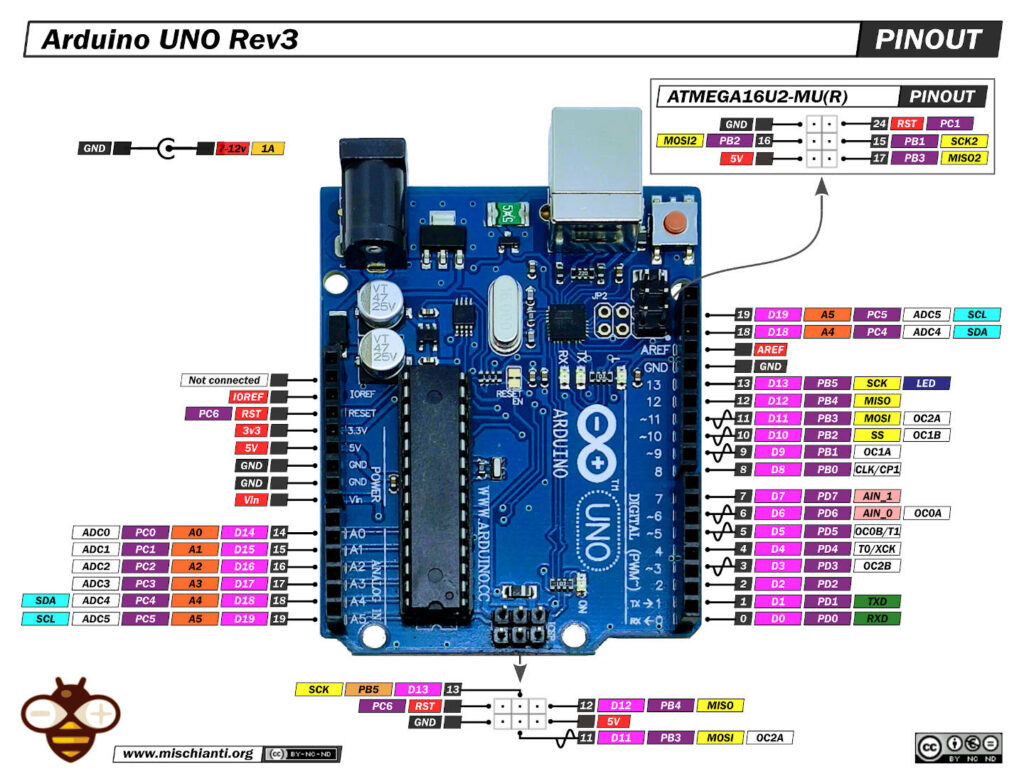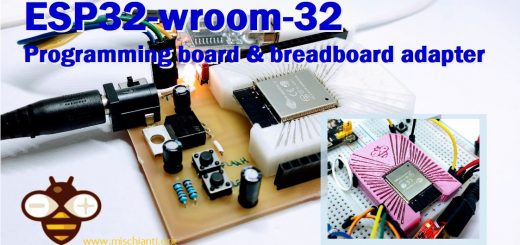Arduino UNO Rev 3: high-resolution pinout, datasheet, and specs
The Arduino Uno is a microcontroller board that serves as a fundamental tool for electronics and coding enthusiasts, educators, and professionals in the development of interactive projects. It’s built around the ATmega328P microcontroller and offers a user-friendly interface, making it an ideal choice for beginners and advanced users alike.

Link to the high-resolution image
Here UNO device Arduino UNO - Arduino MEGA 2560 R3 - Arduino Nano - Arduino Pro Mini
The Arduino Uno is a widely-used microcontroller board based on the ATmega328P, and it comes with a variety of pinout configurations and technical specifications:
Pinout Configuration
- Power: Vin, 3.3V, 5V, GND.
- Reset: Resets the microcontroller.
- Analog Pins (A0 – A5): Provide analog input in the range of 0-5V.
- Digital I/O Pins (0 – 13): Can be used as input or output.
- Serial (0 (Rx), 1 (Tx)): For TTL serial data transmission and reception.
- External Interrupts (2, 3): To trigger interrupts.
- PWM (3, 5, 6, 9, 11): Provide 8-bit PWM output.
- SPI (10, 11, 12, 13): For SPI communication.
- Inbuilt LED (13): Controls the built-in LED.
- TWI (A4, A5): For TWI communication.
- AREF: Reference voltage for input voltage.
Technical Specifications
- Microcontroller: ATmega328P (8-bit AVR family).
- Operating Voltage: 5V.
- Recommended Input Voltage: 7-12V.
- Input Voltage Limits: 6-20V.
- Analog Input Pins: 6 (A0 – A5).
- Digital I/O Pins: 14 (6 provide PWM output).
- DC Current on I/O Pins: 40 mA.
- DC Current on 3.3V Pin: 50 mA.
- Flash Memory: 32 KB (0.5 KB for Bootloader).
- SRAM: 2 KB.
- EEPROM: 1 KB.
- Frequency (Clock Speed): 16 MHz
The function of ATmega16U2 on the Arduino Uno
The ATmega16U2 on the Arduino Uno serves a specific and important function. It acts as a USB-to-serial converter, translating data between the computer’s USB interface and the main microcontroller’s serial communication lines. This functionality is crucial for the Arduino Uno as it allows for:
- Programming: The ATmega16U2 enables the Arduino Uno to be programmed via a USB connection. It receives code from the Arduino IDE (or other programming environments) on the computer and passes it to the main microcontroller (ATmega328P) for execution.
- Serial Communication: It also allows the ATmega328P to communicate with the computer during normal operation, facilitating the sending and receiving of data to and from the Arduino.
This use of a dedicated USB-to-serial chip is a significant upgrade from older Arduino models, which used an FTDI USB-to-serial driver chip. The ATmega16U2 is programmable itself, offering additional flexibility and customizability for advanced users who want to modify its firmware to suit specific USB communication requirements.
Datasheet
Arduino UNO Datasheet
Arduino UNO schematics
Thanks
- Arduino
- esp8285
- esp8266
- ESP32
- DOIT ESP32 DEV KIT v1
- ESP32 DevKitC v4
- ESP32 WeMos LOLIN32
- ESP32 WeMos LOLIN32 Lite
- ESP32 WeMos LOLIN D32
- ESP32-wroom-32
- NodeMCU-32S
- ESP32-S
- ESP32-CAM
- ESP32-2432S028 (Cheap Yellow Display)
- ESP32-2432S032 (Cheap Yellow Display)
- ESP32 s2
- ESP32c3
- ESP32s3
- ESP32c6
- Arduino SAMD
- STM32
- Raspberry Pi










